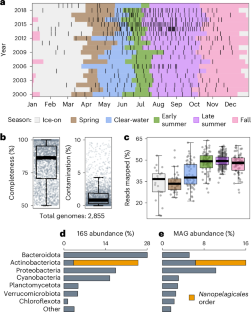2025-01-02 マックス・プランク研究所 (MPG)
 Bat movement over three days shows how many individuals departed on a night of lower air pressure (center).
Bat movement over three days shows how many individuals departed on a night of lower air pressure (center).
© Hurme et al. Science 2025
<関連情報>
- https://www.mpg.de/23893833/1216-ornr-bats-surf-storm-fronts-during-continental-migration-987453-x
- https://www.science.org/doi/10.1126/science.ade7441
コウモリは春の移動中に嵐の前線をサーフィンする Bats surf storm fronts during spring migration
Edward Hurme, Ivan Lenzi, Martin Wikelski, Timm A. Wild, and Dina K. N. Dechmann
Science Published:2 Jan 2025
DOI:https://doi.org/10.1126/science.ade7441
Editor’s summary
Migration is a key component of the lives of many animals, allowing them to take advantage of resources across regions and seasons. We know much about bird migration but a lot less about bat migration, given the difficulty of monitoring large-scale movements of nocturnal animals. Hurme et al. used tiny, highly advanced satellite tags to monitor the spring migration of noctules, which are small insectivorous bats (see the Perspective by McGuire). They found that female bats largely took advantage of warm nights and fronts to migrate to their maternity roosts. However, they showed considerable flexibility, with some individuals waiting until later to begin their journeys and thus incurring an energetic cost. —Sacha Vignieri
Abstract
Long-distance migration, common in passerine birds, is rare and poorly studied in bats. Piloting a 1.2-gram IoT (Internet of Things) tag with onboard processing, we tracked the daily location, temperature, and activity of female common noctules (Nyctalus noctula) during spring migration across central Europe up to 1116 kilometers. Over 3 years, 71 bats migrated tens to hundreds of kilometers per night, predominantly with incoming warm fronts, which provided them with wind support. Bats also showed unexpected flexibility in their ability to migrate across a wide range of conditions if needed. However, females leaving toward the end of the season showed higher total activity per distance traveled, a possible cost for their flexible migration timing.


